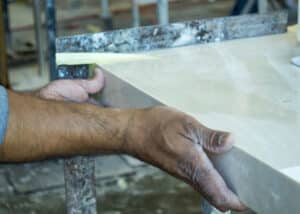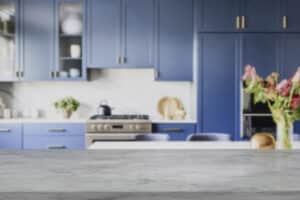
 ☰
☰

 ☰
☰
Natural stone slabs are quarried from all over the world and brought to The Stone Collection. Engineered products, on the other hand, are created in factories before they are shipped to us.
Despite their different origins, both stone products will follow the same process of transformation into a countertop, what we call the fabrication part of the process. We’ve broken the process down into steps below.
Before the fabrication process starts, you must choose what type of stone you want for your countertops. Here’s how the unique Get Inspired™ Experience works at The Stone Collection:

There may be seams that could cause problems if placed at certain locations or might cause difficulty cutting in certain ways. There might also be unattractive spots, including areas where resin fills create an unattractive and unnatural appearance. You can flag spots you want your fabricator to avoid, and they will try to work around them. Your fabricator might also notice ones that you missed and call them to your attention.
Next, the fabricator will take measurements of the space where the countertop will be installed. This will include measurements of the cabinets that will support the countertop, the exact dimensions of the space, and any items that will require cutouts in the countertop, such as the sink and stove.
These measurements are translated into a computerized template that can be overlaid on the slab. This will allow you to envision how the stone slab will become your countertop, so you can see how the cuts work around areas of the stone you might not like as much and foreground the areas of the grain that you do like. You will also get to see how the grain of the slab will orient in your kitchen.
Sometimes, you can tweak the template to get the precise grain orientation you desire, but other times the size and shape of your kitchen might not allow different orientations of the slab.
Now the fabricator will cut the stone. Depending on the fabricator, the cuts might be performed by a diamond-bladed saw or a water jet cutter. Some fabricators use both. The saw cuts faster and works well for straight line cuts, but the water jet works better for more intricate shapes. Other tools might be used for some of the smaller cutouts, depending on the preferences and equipment used by your fabricator. In choosing a fabricator, it’s always good to ask what tools they use, and how accurate their cuts are.
In addition to making the cuts, the countertop can be shaped to give it the precise edge that you desire. Different edge shapes are available to give your countertop the look, feel, and ease of care that you desire.
Once the stone has had its final cuts, it will be finished. The newly cut edges may be polished, and the stone might be sealed. If there are weak spots in the stone, either those you knew about or were revealed by the cutting process, the fabricator will reinforce them. Some stones require sealing or coating at this point to protect them from damage or staining by foods.

All you have to do is drop into one of our warehouse showrooms in Denver, Phoenix, Dallas, Ft. Worth, or Salt Lake City. There you’ll enjoy our exclusive Get Inspired™ Experience. You can browse on your own or get help from one of our stone design experts. They will put their expertise at your service and give you as much information and guidance as you need to identify the best stone for your project. They can offer suggestions about design options and help you understand the benefits and limitations of each material.
Contact us today to learn more or just show up at our showroom to find the right stone slab for your countertop.